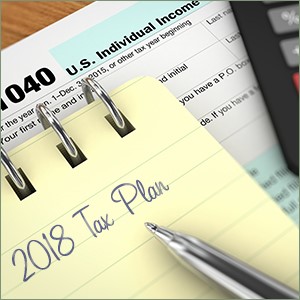 Now is the ideal time to schedule a tax planning session. Your 2017 tax return outcome is still fresh, and it’s early enough in the year to take advantage of the numerous tax law changes taking place in 2018. Here’s a brief overview of some of the new tax issues that you need to plan for now.
Now is the ideal time to schedule a tax planning session. Your 2017 tax return outcome is still fresh, and it’s early enough in the year to take advantage of the numerous tax law changes taking place in 2018. Here’s a brief overview of some of the new tax issues that you need to plan for now.
Income – Tax rates for both individuals and small businesses have changed substantially. Income tax deductions have also changed drastically, including a nearly doubling of the standard deduction and elimination of personal exemptions and miscellaneous itemized deductions.
It’s important to review your income tax withholding schedule to see where you fall in the new income tax bracket structure. Small adjustments here could save you hundreds.
Bunching – Because of the changes to the deductions structure, using itemized deductions may now require bunching two or even three years of expenses into one tax year. Things like donations to charity and medical expenses that you may have spread across several years are now better bunched into a single year to maximize your tax savings.
If you typically take care of medical expenses or charitable donations at a regular time every year, hold off this year until you have a new tax-efficient plan.
SALT (State and local taxes) – There’s now a $10,000 combined total cap on deductions of state and local income, sales and property taxes, which is going to impact a lot of people, especially in high-tax states. This may be a big factor to account for if you’ve relied on this deduction in the past.
Get an analysis done to see how much larger your tax bill is going to be because of the cap on SALT taxes. There may not be much you can do about it, other than changing where you live and own property, but you’ll need to have a clear picture of how it will impact your tax return in 2018.
Mortgage interest changes – There are several new rules changing how mortgage interest is deducted. You can no longer deduct the interest on mortgage indebtedness greater than $750,000. And you can no longer deduct interest on mortgage indebtedness that wasn’t spent directly on buying, building or substantially improving your home.
If you have previously claimed a home equity loan interest deduction, you’ll need to review how this will affect your itemized deductions.
These are just a few examples of things that you’ll need to review in the wake of the largest tax law change in more than 30 years. Take some time this summer to make sure you have a plan in place.
 Getting audited by the IRS is no fun. Some taxpayers are selected for random audits every year, but the chances of that happening to you are very small. You are much more likely to fall under the IRS’s gaze if you make one of several common mistakes.
Getting audited by the IRS is no fun. Some taxpayers are selected for random audits every year, but the chances of that happening to you are very small. You are much more likely to fall under the IRS’s gaze if you make one of several common mistakes.
That means your best chance of avoiding an audit is by doing things right before you file your return this year. Here are some suggestions:
Don’t leave anything out. Missing or incomplete information on your return will trigger an audit letter automatically, since the IRS gets copies of the same tax forms (such as W-2s and 1099s) that you do.
Double-check your numbers. Bad math will get you audited. People often make calculation errors when they do their returns, especially if they do them without assistance. In 2016, the IRS sent out more than 1.6 million examination letters correcting math errors. The most frequent errors occurred in people’s calculation of their amount of tax due, as well as the number of exemptions and deductions they claimed.
Don’t stand out. The IRS takes a closer look at business expenses, charitable donations and high-value itemized deductions. IRS computers reference statistical data on which amounts of these items are typical for various professions and income levels. If what you are claiming is significantly different from what is typical, it may be flagged for review.
Have your documentation in order. Be meticulous about your recordkeeping. Items that will support the tax breaks you take include: cancelled checks, receipts, credit card and investment statements, logs for mileage and business meals and proof of charitable donations. With proper documentation, a correspondence letter from the IRS inquiring about a particular deduction can be quickly resolved before it turns into a full-blown audit.
Remember, the average person has a less than 1 percent chance of being audited. If you prepare now, you can narrow your audit chances even further and rest easy after you’ve filed.
Two-thirds of the Baby Boomer generation are now working or plan to work beyond age 65, according to a recent Transamerica Institute study. Some report they need to work because their savings declined during the financial crisis, while others say they choose to work because of the greater sense of purpose and engagement that working provides. Whatever your reason for continuing to work into your golden years, below is Part 2 of a 2-part series with tips to make sure you get the greatest benefit from your efforts.
4. Consider your expenses. If you’re reducing your working hours or taking a part-time job, you also have to consider the cost of your extra income stream. Calculate how much it costs to commute and park every day, as well as the expense of meals, clothing, dry cleaning and any other expenses. Now consider how much all those expenses amount to in pre-tax income. Be aware whether the benefits you get from working a little extra are worth the extra financial cost.
5. Time to downsize or relocate? Where and how you live can be an important factor determining the kind of work you can do while you’re retired. Downsizing to a smaller residence or moving to a new locale may be a good strategy to pursue a new kind of work and a different lifestyle.
6. Focus on your deeper purpose. Use your retirement as an opportunity to find work you enjoy and that adds value to your life. Choose a job that expresses your talents and interests, and that provides a place where your experiences are valued by others.
One of the most common reasons businesses fail is due to lack of understanding of cash flow. The same can be said about your household’s personal financial statement. So what is this cash flow concept, how does it apply to you, and what are some ways to improve yours? In Part 1 of this two-part article, we explained explain what cash flow is and how to determine your cash flow. In Part 2, we’ll give you some ways to improve your cash flow.
Identify your challenges. See if you have months where more cash is going out than is coming into your bank account. This is often when large bills are due. Try to balance these known high-expense months out over the year if at all possible. Common causes are:
- The holidays
- Property tax payments
- Car and homeowners insurance
- Annual income tax payments
- Vacations
Build a reserve. If you know there are challenging months, project how much additional cash you will need and begin to save for this reserve in positive cash months.
Cut back on annuities. See what monthly expense drivers are in your life. Can any of them be reduced? Can you live with fewer cell phone add-ons? How about cutting costs in your cable bill? Is it time for an insurance review?
Shop your current services. Some of your larger bills may create an opportunity for savings. This is especially true with homeowners and car insurance.
Don’t confuse savings with cash flow. Think of your savings as the accumulation of positive cash flows from prior months. A high savings balance can often mask a monthly cash flow problem where more is going out than is coming in over a period of time.
Create savings “expense” to add to cash flow. Consider adding a “bill to yourself” in your cash outflows. This money saved is a simple technique to create positive cash flow each month to build an emergency reserve.
Most everyone knows you need to budget, balance and save. However, here’s a list of the ten steps to ensure you walk on stable financial ground.
- Set a budget and stick to it – Make financial goals and then create a budget that supports those goals. Account for expenses on a monthly basis and set budget limits for dinner out and other forms of entertainment.
- Pay off all debt (except a home mortgage) – Make debt payments a part of your budget until paid off.
- Set aside money for future expenses – Plan in advance for both short- and long-term big expenses and create a line item for them in your monthly budget.
- Save for emergencies – Set aside funds each month to build a reserve of three months living expenses (eventually build up to six) to guard against job loss or unexpected expenses. Having these savings automatically deducted you’re your income makes it easier.
- Take advantage of available plans – Company-sponsored 401(k) plans and/or other retirement plans, 529 savings plans and education funds will help you financially later. A little put away today can mean a lot is available tomorrow.
- Spend only what you have – Limit uses of credit vehicles like credit cards and high interest cash advances. Pay off credit cards by due dates each month.
- Manage your financial life – Regularly manage and monitor your accounts and statements, including balancing your debit/checking account and investment accounts.
- Keep an eye on your credit score – Making timely payments is one of the best ways to maintain good credit for future lending. If used responsibly, automatic payment systems like online banking can be beneficial.
- Set up Identity Theft Protection on your financial accounts – Regularly change your online and mobile passwords, and safeguard your financial statements.
- Openly communicate with your spouse about your family’s financial position – Make sure you both agree on short- and long-term goals. Teach your children the power of saving and budgeting to put them on the path to a successful financial future.